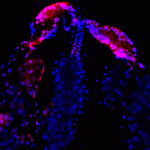 On the cover: Type IV pili (T4P), long and flexible appendages at the surface of many bacteria, are critical virulence factors. Pili of enterohemorrhagic E. coli (EHEC), an important human pathogen, are polymers of the major subunit PpdD. In the quest for drug and vaccine discovery against such pathogens, unraveling the detailed organization and dynamics of PpdD pili will be instrumental. By combining NMR and cryo-EM, Bardiaux et al. (pp. 1082–1093) add a new page to the coloring book of T4P atomic models. The EHEC T4P structure revealed a large extended region of the pilin stem correlating with extremely high pilus flexibility, along with residues crucial for its assembly and stability. Image created by Benjamin Bardiaux (CNRS/Institut Pasteur, Paris). https://doi.org/10.1016/j.str.2019.03.021
On the cover: Type IV pili (T4P), long and flexible appendages at the surface of many bacteria, are critical virulence factors. Pili of enterohemorrhagic E. coli (EHEC), an important human pathogen, are polymers of the major subunit PpdD. In the quest for drug and vaccine discovery against such pathogens, unraveling the detailed organization and dynamics of PpdD pili will be instrumental. By combining NMR and cryo-EM, Bardiaux et al. (pp. 1082–1093) add a new page to the coloring book of T4P atomic models. The EHEC T4P structure revealed a large extended region of the pilin stem correlating with extremely high pilus flexibility, along with residues crucial for its assembly and stability. Image created by Benjamin Bardiaux (CNRS/Institut Pasteur, Paris). https://doi.org/10.1016/j.str.2019.03.021
 On the cover: In many bacteria, virulence depends on Type IV pili (T4P), long proteinaceous polymers exposed at the bacterial surface with an intrinsic flexible nature. Karami et al. (1397–1409) performed extensive MD simulations to characterize the conformational landscape of these pili. The resulting “motion picture” provides insight into the role of calcium and physico-chemical interactions in modulating filament flexibility. Illustration created by Benjamin Bardiaux and Yasaman Karami (CNRS/Institut Pasteur, Paris). https://doi.org/10.1016/j.str.2021.07.008
On the cover: In many bacteria, virulence depends on Type IV pili (T4P), long proteinaceous polymers exposed at the bacterial surface with an intrinsic flexible nature. Karami et al. (1397–1409) performed extensive MD simulations to characterize the conformational landscape of these pili. The resulting “motion picture” provides insight into the role of calcium and physico-chemical interactions in modulating filament flexibility. Illustration created by Benjamin Bardiaux and Yasaman Karami (CNRS/Institut Pasteur, Paris). https://doi.org/10.1016/j.str.2021.07.008




































